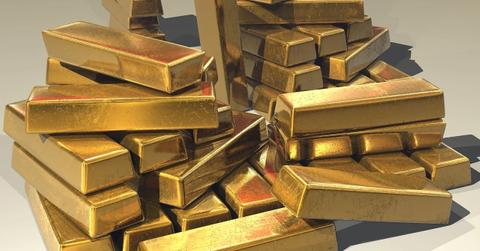Gold Prices: Undervaluation, Smart Money Piles Up
Since March, gold prices are on a tear due to uncertainty surrounding COVID-19. The SPDR Gold Shares has seen gains of 16.2% since March 18.
May 12 2020, Published 12:03 p.m. ET

Since March, gold prices are on a tear due to uncertainty surrounding COVID-19. The SPDR Gold Shares (NYSEARCA:GLD) has seen gains of 16.2% since March 18. The VanEck Gold Miners ETF (NYSEARCA:GDX) has amplified these returns by gaining 64% during the same period.
Gold prices gain on uncertainty and fear
In times of uncertainty and fear, gold usually rises due to its safe-haven demand. Currently, to avoid the looming slowdown due to COVID-19, central banks engage in an easy money policy. Central banks, including the Federal Reserve, print money quickly. The move will have ripple effects through economies, most of which are positive for gold.
Easy money policy to prop gold prices up
On one hand, economic stimulus packages will lead to currency devaluations, which should prop gold up. On the other hand, easy money, without any corresponding rise in output, will lead to inflation. This scenario is positive for gold. Moreover, central banks have taken interest rates to near zero. Low rates and huge budget deficits are a perfect recipe for rising gold prices.
Hedge fund managers placing bets
Now, hedge funds have also started jumping into gold. According to the Financial Times, Elliott Management, Caixin Associates, and Dymon Asia Capital have been betting on gold in 2020.
Paul Singer thinks gold is undervalued
According to Financial Times, Elliott Management’s Paul Singer told his clients that gold was “one of the most undervalued” assets currently and its fair value is “multiples of its current price.”
Many other market participants including ANZ bank also think that gold is undervalued and could push higher. Gold prices are undervalued compared to equities. Currently, the ratio of GLD to the S&P 500 (NYSEARCA:SPY) is 0.55. In comparison, the last ten-year average is 0.73. If a mean reversion occurs, gold prices will rise or equities will fall.
Ray Dalio and David Einhorn’s views
Having gold in their portfolios is usually a sound strategy for retail investors. Bridgewater Associates’ Ray Dalio also advises investors to have gold for diversification and as an inflation hedge. He recommends that investors’ portfolios have a 5%–10% gold allocation.
Greenlight Capital’s (NASDAQ:GLRE) David Einhorn also likes gold. During the investor letter for the first quarter of 2020, the firm said, “We believe the implied negative real interest rates are bullish for gold and for unlevered real assets with pricing power.”
DoubleLine Capital’s Jeffrey Gundlach tweeted on April 21 that he foresees an opposite dynamic to oil potentially playing out in gold. He expects the demand for physical delivery to outstrip what the counterparty can deliver.
Bank of America, JPMorgan Chase, and UBS
Apart from hedge fund managers, analysts are also making a case for gold. Bank of America expects gold prices to reach $3,000 per ounce in 18 months. Bank of America analysts wrote that investors will look to gold, “As economic output contracts sharply, fiscal outlays surge, and central bank balance sheets double, fiat currencies could come under pressure.”
JPMorgan Chase advises that investors hedge their risks with gold as pandemic-induced uncertainty rises.
UBS also believes that gold has “growing potential” to break $1,800 per ounce. UBS analyst Joni Teves thinks this is due to the environment of uncertainty and negative real rates.
Gold for portfolio diversification and hedging purposes
However, other people don’t believe in gold. Berkshire Hathaway’s chairman, Warren Buffett, has expressed his dislike for gold time and again. While gold might not be able to outperform equities over the long term, it’s important from the diversification and hedge point of view.
